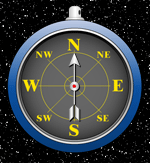 |
Artist's concept of
ordinary compass action.
|
The Inertial Stellar Compass, referred to here as Compass, is a real-time, miniature, inertial stellar attitude determination system. In simple terms, this is a system that periodically uses a star camera to tell the spacecraft where it is pointing and gyroscopes to continuously monitor the spacecraft's motion. The gyroscopes also inform the control system how to keep the spacecraft stable and pointed in the right direction, in case the camera is "blinded" by the Sun. Periodic updates from the star camera allow the continuous gyro information to be corrected for drift and bias. Such systems have been in use for awhile as individual devices, but never as a small, integral, low power package.
What is unique about Compass is that information from two miniaturized devices is integrated. Combining these two devices in a very low-mass and low-power unit——with enough performance——is revolutionary. These are important features for the new, smaller spacecraft and satellites of the future. When a gyro assembly and star camera are used together, the spacecraft has a more robust system to determine attitude accurately without the shortcomings of either device.
Compass technology uses an active pixel sensor in a wide-field-of-view miniature star camera——often referred to as a star tracker——and microelectromechanical system (MEMS) gyros. Together, they provide extremely accurate information for navigation and control.
Compass is built as two connected assemblies: the camera-gyro assembly (CGA) and the data processor assembly (DPA). The CGA is separated from but interconnected to the DPA. Compass will provide precision attitude determination for long-duration space science missions. A spacecraft using Compass technology will be able to continuously sense its position. It will also be able to recover its orientation after a temporary malfunction or power loss. Additionally, Compass technology reduces risk for large and medium size spacecraft and allows additional mass and power to be used for scientific payloads (instruments). Draper Laboratory is the technology provider of this experiment, which launched on the TacSat-2 microsatellite on December 16, 2006.
Technology descriptions and validation results are documented in the following papers:
Brady, T. , et al., "The Inertial Stellar Compass: A New Direction in Spacecraft Attitude Determination." Presented at the AIAA16th Annual USU Conference on Small Satellites, paper SSC02-II-1.
Brady, T. , et al., "The Intertial stellar Compass: A Multifunction, Low-power, Attitude Determination Technology Breakthrough." American Astronomical Society, AAS 03-003.
Brady, T. , et al., "Ground Validation of the Inertial Stellar Compass." 0-7803-8155-6/04/$17.00 (c) 2004 IEEE, IEEEAC paper #1358, version 1, Updated December 09, 2003.